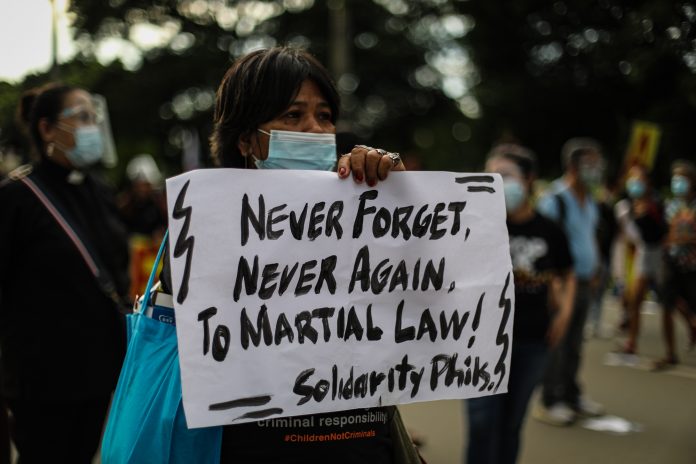They deserve to die. They are activists and the noisy ones. The Philippines is peaceful without them.
These are comments one can read after stories of human rights violations during the Marcos dictatorship came out on social media.
During the online session dubbed “Evening of Truth,” martial law survivor Oscar Labastilla shared what happened in the village of Tagapua, San Franciso, in Agusan del Sur province, in January 1973.
Labastilla’s daughter, Skeeter, later wrote the story about what living in fear and in the mid of violence feels like.
In 1973, about 300 Manobo people — men, women and children — lived in the village of Tagapua, tending a farm, raising animals, and weaving.
But the Philippine Constabulary came and started harassing the tribe by taking the harvest and the animals.
The Manobos were helpless and furious.
Then a referendum was held from January 10 to 15, 1973, to ask Filipinos if they wanted the martial law to continue or not.
One classroom was assigned for the Manobos of Tagapua where they all voted “No.”
The teachers assigned to oversee the referendum were, however, instructed by officials of the Presidential Assistant on Community Development to report at least a 90 percent “Yes” vote.
The helpless teachers followed.
Angry, the Manobos attacked the teachers, almost beheading one.
Someone reported the incident to the town priest, a Dutch named Father Engelbert, who went to the school supervisor, a Mr. Porfonio Lapa, for help.
The school supervisor was the father of Baltic Lapa, Labastilla’s former roommate in an apartment while they were both working at the Provincial Assessor’s Office.
Mr Lapa went to confide with his son Engineer Baltic Lapa.
Labastilla was with Baltic when Mr Lapa arrived. It was about five o’clock in the afternoon.
Mr Lapa told his son Baltic that there was an emergency in Tagapua where a teacher was killed by the Manobos.
Baltic was hesitant in going to the village because he had fever. He gave his blue jacket to his father along with some medicine.
Mr. Lapa, accompanied by the Dutch priest, Engelbert, and a policeman left for Tagapua.
They never came back.
Past midnight, the police came and asked Baltic and Labastilla to identify bodies at the morgue.
Mr Lapa’s head was on the table, barely connected to his neck. He was still wearing the blue jacket Baltic gave him.
There was a bloodbath the following week.
The Constabulary stormed Barangay Tagapua and killed at least eight people who fought with their bolo against the guns of the PC.
This incident was never reported.
In her story, Sketeer asked: Who was to blame?
“Who created the monster out of the Manobos but the Philippine Constabulary? Who created the monster out of the PC but the unquestioned power of martial law?” she wrote.
Many argue that Marcos’ reign was the “golden age” of the country.
However, many fail to see and understand what really went on behind the “discipline” that the Marcos administration forced on individuals — the curfews, veiled threats, detention, torture, disappearances, and death.
Life under the dictatorship was deadly, especially for those who stood against the dictator.
“Our martial law experience bore strange unwanted fruits xxx the colossal damage wrought under the oppressive conditions of the period. The cries of justice for the tortured, the murdered, and the desaparecidos arouse outrage and sympathy in the hearts of the fair-minded, yet the dispensation of the appropriate relief due them cannot be extended through the same caprice or whim that characterized the ill-wind of martial rule,” the Supreme Court said in the case of Mijares vs Ranada (G.R. No. 139325 April 12, 2005).
Atty. Dennis Gorecho heads the seafarers’ division of the Sapalo Velez Bundang Bulilan law offices. For comments, email [email protected], or call 09175025808 or 09088665786.









